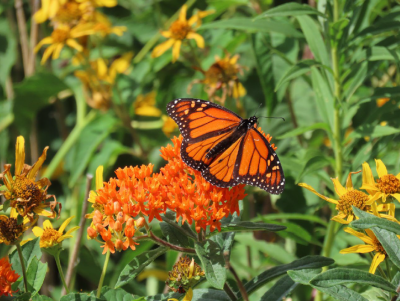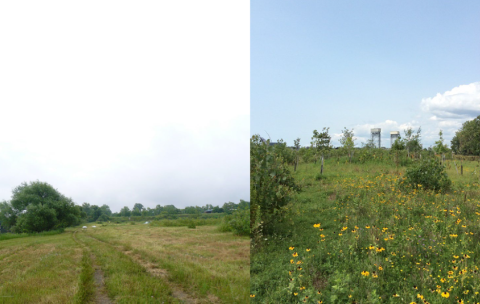Together with the New York State Department of Environmental Conservation (NYSDEC), Buffalo Niagara Waterkeeper, Erie County and the Buffalo River Remedial Advisory Committee (BRRAC), the U.S. EPA has announced the removal of the Loss of Fish and Wildlife Habitat Beneficial Use Impairment (BUI) at the Buffalo River Area of Concern (AOC). This BUI was removed on July 19, 2023. BUIs are designations listed in the 1987 amendment to the Great Lakes Water Quality Agreement that represent different types of significant environmental degradation (see Beneficial Use Impairments for the Great Lakes AOCs to learn more). The GLRI provided significant funding for the habitat restoration work required to remove this BUI.
The Buffalo River Area of Concern, once a shallow wetland habitat, has been significantly impacted by human industrial activity. These activities have resulted in a physically altered river channel, decreased stream flow, absent aquatic vegetation, steep and hardened shorelines, exacerbated low dissolved oxygen, and other effects that have left conditions poor for native fish and wildlife species. NYSDEC and the BRRAC worked with local and federal partners to take the following actions to improve habitat connectivity and water quality within the AOC, and ultimately remove the Loss of Fish and Wildlife Habitat BUI.
In 2013, the BRRAC developed a Habitat Action Plan in which they identified project sites and set a target to restore at least 25% of shoreline within the AOC to improve habitat connectivity. The Action Plan entailed extensive habitat restoration work, including establishing natural shoreline slopes above and below the water line, replacing invasive riparian plants with native species, and re-establishing aquatic vegetation. In total, project partners restored nearly 30,000 linear feet of shoreline – exceeding the goal for removing this BUI. Alongside this restoration work, partners installed structures for fish and wildlife, such as submerged root wads for underwater fish habitat and bird houses for shelter and nesting. Additionally, in 2017 the City of Buffalo enacted the Buffalo Green Code, which requires a 100-foot vegetated setback for all new shoreline developments. This code protects the habitat areas restored under the Habitat Action Plan and the majority of the shoreline within the Buffalo River AOC from future urban development.
Dissolved oxygen levels are naturally low in the AOC section of the Buffalo River, but human impacts had significantly decreased oxygen below natural historical levels. In order to meet their criteria for improving water quality and removing the Loss of Fish and Wildlife Habitat BUI, NYSDEC worked with local and federal partners to improve wastewater and stormwater management and dredging practices within the AOC to minimize negative impacts. Dissolved oxygen conditions will also be improved by work completed under the Habitat Action Plan, especially the establishment of native riparian and aquatic vegetation. Through these efforts, the primary human-driven causes of dissolved oxygen have been addressed, and these factors are no longer limiting the support of aquatic life in the Buffalo River AOC.
The Buffalo River is a vital ‘working’ river and will continue to be used for industrial and commercial endeavors. However, the actions taken to remove the Loss of Fish and Wildlife Habitat BUI have helped to minimize the impacts of poor habitat conditions and water quality on local fish and wildlife, and shoreline habitat will continue to be protected from urban developments under the new Buffalo Green Code. This BUI is the fourth to be removed from the Buffalo River AOC, and five BUIs remain before the AOC is eligible for delisting.



